We're excited to offer a range of professional tests right here in the Human performance Laboratory. Whether you're an athlete or not, these tests are a great way to get an insight into your fitness levels.

Welcome to the Human Performance Laboratory
Meet Jack Cunnington, manager of the Human Performance Laboratory at Lancaster University.
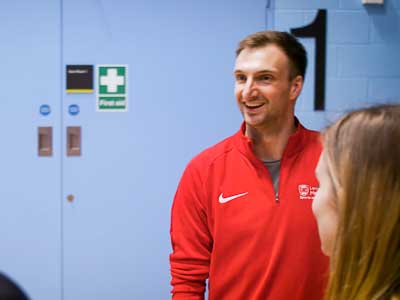
Meet Jack Cunnington
I’m Jack Cunnington and I’m the Human Performance Laboratory (HPL for short) Manager.
I studied Sports and Exercise Science for my own undergraduate degree at Leeds Beckett University (though it was called Leeds Metropolitan when I was there). After that, I worked there as a learning support officer. Coming to Lancaster was an opportunity to put my stamp on things as part of the team that set up a brand-new programme.
I’ve been given the opportunity, in setting this programme up from scratch, to choose exactly the pieces of equipment that I want for the HPL. Because it’s a small team, I work closely with my academic colleagues in choosing what they want. Our lab is tailored very specifically to the research and teaching that we do here.
As a small course, we can afford to get the absolute best research-grade kit that our students can use as well as our research team.
Biodex Isokinetic Dynamometer
I lead on lab health and safety. As you can imagine, in the lab there are lots of activities that have potential risks: maximal exercise, taking blood samples, things like that. So early on in first year we cover health and safety and risk assessments. It’s pretty dry stuff but honestly, it’s one of the most important things students do. When they graduate and go into a Clinical setting or a Sports Science lab, the minimum they’ll be expected to do is work safely.
The equipment that we use here and train the students on is used in both research and applied settings like a Premier League football club. For example, the isokinetic dynamometer (Biodex) over there will be used by Premier League clubs as a screening tool. When they sign a player for millions and millions of pounds they want to make sure that they are injury free, so they’ll use a piece of equipment like the Biodex to test their muscle function (imbalances between right and left, or quads and hamstrings) before they sign.
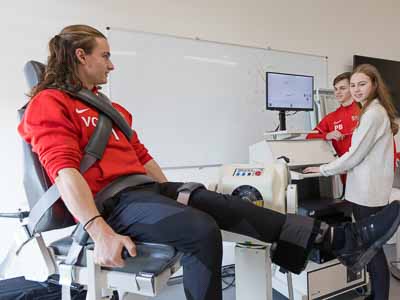
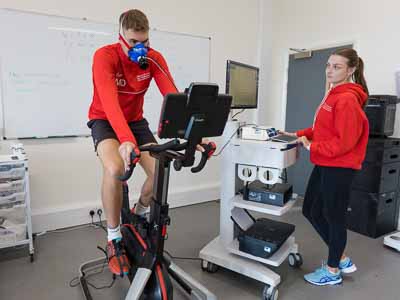
Wattbike
The Wattbike Atom X is used by in rugby, and British cycling. In Rugby you might see them on the side of the pitch as players warm up or warm down, or prepare to come back onto the field. They’re really good for measuring performance over time and keeping track of fitness changes throughout a season. They are an elite performance tool, used by the New Zealand All Blacks, as an example. There are lots of good stationary bikes on the market, but we like the Wattbike because of the way it replicates the feel of a real bike and how it manages resistance changes.
Research-grade Treadmill
The treadmill is not the average treadmill that you would see in a gym. It’s designed for elite athletes to run on and so has a top speed of 40kph (which is about twice what you get on a gym treadmill), it can be set at a 25% incline, and it can be set to run backwards. This allows us to use running downhill as a test which is a specific test in sports science that tests muscle damage. When you run downhill your muscles are both contracting and lengthening at the same time as you are effectively trying to break yourself. Those eccentric muscle contractions produce micro-tears in your muscles. DOMS (Delayed Onset Muscle Soreness) is the feeling you get when your muscles are sore a day or two after exercising. Those are basically micro-tears in your muscle fibres. We do this to look at how to aid muscle recovery.

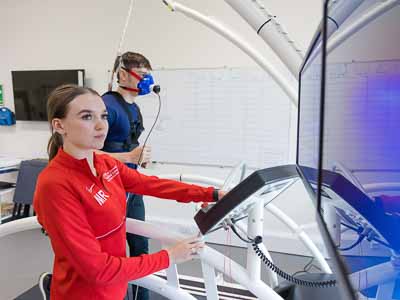
Cortex Gas Analysers
The gas analysers measure how much oxygen someone is using and how much carbon dioxide they are producing. They’re probably the most widely recognised bit of sports science kit; you see the person running on the treadmill with the mask on measuring volume and composition of breathing. Gas analysers measure a couple of things for example we us them to perform a VO2 Max test, a proxy for measuring how fit someone is. A VO2 Max test lasts about ten minutes. You start with some basic level of exercise that’s appropriate for the subject and then every minute you increase the work in some way. That might be speed, incline, or resistance, and the point is for the participant to exercise until volitional exhaustion, or the point where there is no more O2 consumption irrespective of any further increases in work load.
In taught practical sessions we expect our students to volunteer as the test subjects, and so as a consequence they do get a VO2 Max test that in theory could be useful for their own fitness development. They tend to be the endurance athletes amongst our students.
Cycling ergometer
We have a cycling ergometer for the Wingate Anaerobic test. It’s a brutal test and is one of the most widely used tests in sports science. It’s an all-out sprint on the bike set against a resistance of 7.5% of your body weight. That makes it individualised for each person. You load the weights, ask the participant to get up to speed and then drop the weights. It’s a huge change in resistance. They then have to pedal as hard as they can for 30 seconds. It tests maximum power output, the time it takes to get to max power – which should be more or less in the first few seconds – and how long they can sustain that. By the end of thirty seconds the participant is usually struggling to turn the pedals. How participants fair on the test really depends on the sport they play. An elite rugby player would typically have a huge initial spike as they put the power down, but then tail off very quickly. A pro-cyclist may not be able to reach the same max power, but may be able to sustain their output for longer. It really depends.
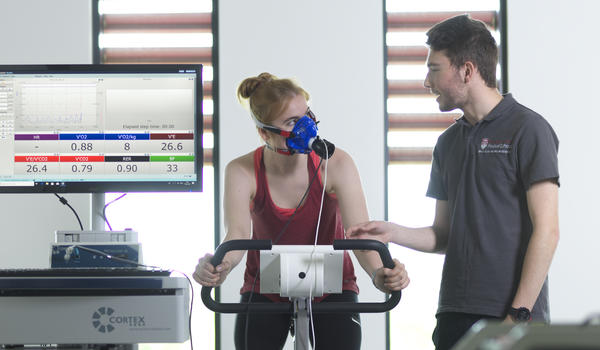
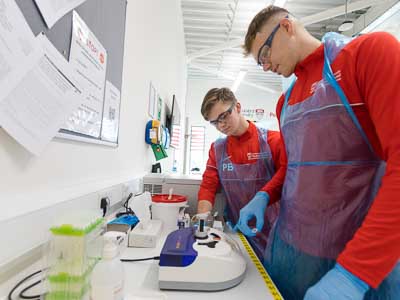
Clinical scenarios
Being based in the Medical School we cover a lot of the health and the clinical aspects of sports and exercise science. That’s a bigger area with more opportunities, with many roles available across public health. All the tests we do here exist on a spectrum. So, at the top end we’re testing elite athletes and looking at incremental performance improvements. But the same tests can be used to measure anyone’s fitness levels. Dr Chris Gaffney does his research on colorectal cancer patients, they have to do a VO2 max test before surgery to prove they are fit enough to survive the surgery (or give them the best chance of a good outcome).
We use ECG machines to measure heart rhythms, which is an obvious clinical tool.
Blood analysis
We have various blood analysers, the main one is the Biosen Glucose and Lactate analyser. Blood glucose is a screening test used as a measure for diabetes or impaired glucose tolerance. But in exercise, glucose might go up as the body breaks down glycogen for energy. And we do lactate threshold tests, similar to a VO2 Max test but the increment periods are longer (say, four minutes) and we test blood at the end of each period looking for a lactate curve. It’s used to plot an exercise training zone.
Students use these different pieces of equipment right from the start. The first-year Introduction to Physiology module is designed to make them competent on all of the bits of kit we use in the lab, and that they will use across all three years (and possibly beyond). They also learn how to take blood, measure blood pressure and height, weight, waist circumference which they will do more or less constantly throughout their degree.
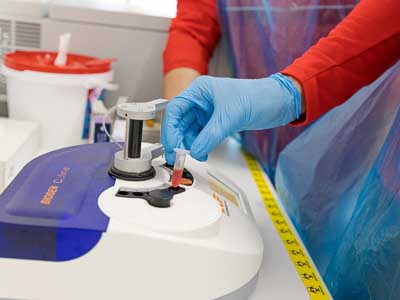
Our students show you Sports and Exercise Science's focus on people - in sports and beyond, how they are supported and nurtured by our academic team, and how studying at Lancaster has given them the confidence to take their studies wherever they want.

